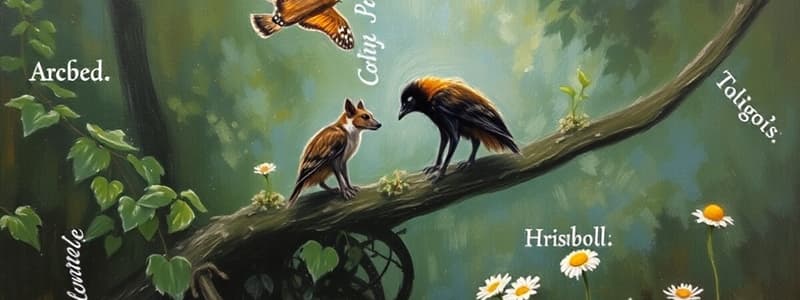Podcast
Questions and Answers
What does species richness measure in a community?
What does species richness measure in a community?
- The variety of different species present
- The total biomass of the community
- The total number of different species (correct)
- The proportion each species represents of the total individuals
How does relative abundance contribute to species diversity?
How does relative abundance contribute to species diversity?
- It measures the total biomass of the community
- It indicates the variety of different species present
- It only considers the total number of individuals
- It shows the frequency of each species in relation to others (correct)
Which scenario best describes a community with high species diversity?
Which scenario best describes a community with high species diversity?
- Only a few species are present in high abundance
- Many species are present but all have low populations
- All species have similar population sizes (correct)
- One or two species are highly abundant while others are rare
What is the impact of interspecific competition on species interactions?
What is the impact of interspecific competition on species interactions?
Which of the following statements regarding species abundance is true?
Which of the following statements regarding species abundance is true?
What defines an ectoparasite?
What defines an ectoparasite?
In mutualism, which of the following statements is true?
In mutualism, which of the following statements is true?
Which type of mutualism requires one species to survive?
Which type of mutualism requires one species to survive?
What is an example of commensalism?
What is an example of commensalism?
Which of the following describes both endoparasites and ectoparasites?
Which of the following describes both endoparasites and ectoparasites?
What occurs when two species compete for the same limited resource?
What occurs when two species compete for the same limited resource?
What defines the fundamental niche of an organism?
What defines the fundamental niche of an organism?
What is a likely outcome when two species with identical niches compete for resources?
What is a likely outcome when two species with identical niches compete for resources?
What describes the realized niche of an organism?
What describes the realized niche of an organism?
Which of the following is NOT an example of interspecific interaction?
Which of the following is NOT an example of interspecific interaction?
Which principle states that two species competing for the same limiting resources cannot coexist in the same place?
Which principle states that two species competing for the same limiting resources cannot coexist in the same place?
What often leads to resource partitioning between species?
What often leads to resource partitioning between species?
What is the effect of strong interspecific competition?
What is the effect of strong interspecific competition?
What defines a dominant species in an ecosystem?
What defines a dominant species in an ecosystem?
How does primary production impact the energy budget of an ecosystem?
How does primary production impact the energy budget of an ecosystem?
What is a key characteristic of invasive species?
What is a key characteristic of invasive species?
Which of the following concepts best describes the interconnected nature of food chains?
Which of the following concepts best describes the interconnected nature of food chains?
What role do keystone species play in an ecosystem?
What role do keystone species play in an ecosystem?
What is character displacement primarily concerned with?
What is character displacement primarily concerned with?
Which of the following is NOT a feeding adaptation of predators?
Which of the following is NOT a feeding adaptation of predators?
What adaptation might a prey animal use to signal danger to others?
What adaptation might a prey animal use to signal danger to others?
In Batesian mimicry, which statement is true?
In Batesian mimicry, which statement is true?
What type of relationship does herbivory refer to?
What type of relationship does herbivory refer to?
Which of the following is a type of symbiotic relationship?
Which of the following is a type of symbiotic relationship?
What is aposematic coloration primarily used for?
What is aposematic coloration primarily used for?
Which of the following accurately describes Müllerian mimicry?
Which of the following accurately describes Müllerian mimicry?
What does species richness indicate about a community?
What does species richness indicate about a community?
How does a community with even species abundance compare to one with unequal distribution?
How does a community with even species abundance compare to one with unequal distribution?
What do interspecific interactions primarily refer to?
What do interspecific interactions primarily refer to?
What is relative abundance in the context of species diversity?
What is relative abundance in the context of species diversity?
Which statement about species interactions in a community is true?
Which statement about species interactions in a community is true?
What defines the relationship in mutualism?
What defines the relationship in mutualism?
Which of the following best illustrates commensalism?
Which of the following best illustrates commensalism?
Which type of parasitism lives on the external surface of its host?
Which type of parasitism lives on the external surface of its host?
What is the difference between obligate and facultative mutualism?
What is the difference between obligate and facultative mutualism?
Which of the following is an example of an endoparasite?
Which of the following is an example of an endoparasite?
What is the primary factor that limits photosynthetic output in ecosystems?
What is the primary factor that limits photosynthetic output in ecosystems?
Which type of species has the highest biomass and can control the distribution of other species in an ecosystem?
Which type of species has the highest biomass and can control the distribution of other species in an ecosystem?
What role does primary production play in an ecosystem?
What role does primary production play in an ecosystem?
What describes the interconnected structure of food chains within an ecosystem?
What describes the interconnected structure of food chains within an ecosystem?
What typically characterizes invasive species in a new ecosystem?
What typically characterizes invasive species in a new ecosystem?
What do predators use to improve their chances of capturing prey?
What do predators use to improve their chances of capturing prey?
Which of the following best defines aposematic coloration?
Which of the following best defines aposematic coloration?
In Batesian mimicry, which outcome occurs?
In Batesian mimicry, which outcome occurs?
What kind of adaptations do plants develop due to herbivory?
What kind of adaptations do plants develop due to herbivory?
What is the relationship type for symbiosis?
What is the relationship type for symbiosis?
Which strategy is NOT typically used by prey to avoid predation?
Which strategy is NOT typically used by prey to avoid predation?
Müllerian mimicry involves which of the following?
Müllerian mimicry involves which of the following?
What can be a consequence of strong interspecific competition between two species?
What can be a consequence of strong interspecific competition between two species?
Which term describes the niche an organism occupies in the presence of competition?
Which term describes the niche an organism occupies in the presence of competition?
How does resource partitioning allow species to coexist?
How does resource partitioning allow species to coexist?
What is the competitive exclusion principle also known as?
What is the competitive exclusion principle also known as?
The total requirements of a species for all resources and conditions define which of the following?
The total requirements of a species for all resources and conditions define which of the following?
Which of these scenarios best describes competitive exclusion?
Which of these scenarios best describes competitive exclusion?
What is a key difference between fundamental and realized niches?
What is a key difference between fundamental and realized niches?
What typically allows coexistence of two species with identical ecological niches?
What typically allows coexistence of two species with identical ecological niches?
Flashcards
Species Diversity of a Community
Species Diversity of a Community
The variety of organisms in a community, consisting of species richness and relative abundance.
Species Richness
Species Richness
The total number of different species in a community.
Relative Abundance
Relative Abundance
The proportion of each species' individuals compared to the total in a community.
Interspecific Interactions
Interspecific Interactions
Signup and view all the flashcards
Interspecific Competition
Interspecific Competition
Signup and view all the flashcards
Competitive Exclusion
Competitive Exclusion
Signup and view all the flashcards
Ecological Niche
Ecological Niche
Signup and view all the flashcards
Competitive Exclusion Principle
Competitive Exclusion Principle
Signup and view all the flashcards
Fundamental Niche
Fundamental Niche
Signup and view all the flashcards
Realized Niche
Realized Niche
Signup and view all the flashcards
Resource Partitioning
Resource Partitioning
Signup and view all the flashcards
Parasitism
Parasitism
Signup and view all the flashcards
Endoparasite
Endoparasite
Signup and view all the flashcards
Ectoparasite
Ectoparasite
Signup and view all the flashcards
Commensalism
Commensalism
Signup and view all the flashcards
Mutualism
Mutualism
Signup and view all the flashcards
Character Displacement
Character Displacement
Signup and view all the flashcards
Predation (+/-)
Predation (+/-)
Signup and view all the flashcards
Prey Strategies
Prey Strategies
Signup and view all the flashcards
Aposematic Coloration
Aposematic Coloration
Signup and view all the flashcards
Batesian Mimicry
Batesian Mimicry
Signup and view all the flashcards
Herbivory (+/-)
Herbivory (+/-)
Signup and view all the flashcards
Symbiosis
Symbiosis
Signup and view all the flashcards
Cryptic Coloration
Cryptic Coloration
Signup and view all the flashcards
Dominant Species
Dominant Species
Signup and view all the flashcards
Invasive Species
Invasive Species
Signup and view all the flashcards
Keystone Species
Keystone Species
Signup and view all the flashcards
Primary Production
Primary Production
Signup and view all the flashcards
Food Web
Food Web
Signup and view all the flashcards
Predation
Predation
Signup and view all the flashcards
Prey Adaptations
Prey Adaptations
Signup and view all the flashcards
Herbivory
Herbivory
Signup and view all the flashcards
Lichen Structure
Lichen Structure
Signup and view all the flashcards
Study Notes
Community Ecology
- Community ecology studies the variety of organisms within a community.
- Species diversity consists of two major components:
- Species richness: the total number of different species within a community.
- Relative abundance: the proportion of each species compared to the total number of individuals in the community.
- Two communities can have the same species richness, yet a different relative abundance.
- A community possessing an even species abundance is more diverse than one dominated by one or two abundant species.
Ecological Interactions
- Interspecific interactions involve relationships between different species in a community.
- Examples include competition (-/-), predation (+/-), herbivory (+/-), symbiosis (parasitism (+/-), mutualism (+/+), commensalism (+/0)), and disease.
- Competition occurs when different species compete for a limited resource.
- Competitive exclusion occurs when strong competition results in the elimination of one of the two competing species.
- The ecological niche is the total use of biotic and abiotic resources by an organism in its environment.
- The competitive exclusion principle (Gause's Law) states that two species competing for the same limiting resource cannot coexist in the same place.
- Coexistence occurs when overlap between niches is reduced.
Experimental Evidence (Paramecium)
- Species grown alone and together exhibit differing population densities over time.
Ecological Niche
- The total requirements of a species for all resources determine where it can live.
- The niche of an organism depends on location and behavior.
Fundamental and Realized niche
- Fundamental niche: the potential ecological niche of an organism when competition is absent.
- Realized niche: the niche an organism actually occupies in the presence of competition.
- Examples show how competition can alter an organism's niche.
Resource Partitioning
- Resource partitioning is the differentiation of niches that enables similar species to coexist in a community.
- Competition between species with identical niches can result in species extinction.
- Evolution by natural selection leads to the modification of resources utilized by one species.
- This results from species evolving to use different resources, avoid competition and potentially coexist
Character Displacement
- Character displacement is the tendency for characteristics to be more divergent in sympatric populations of two species.
- Competing species evolve slightly different niches to avoid competition.
- Reduces interspecific competition.
- An example: variations in beak size between populations of two Galapagos finch species.
Predation (+/-)
- Predation is the interaction where one species (predator) kills and eats another (prey).
- Predators often possess adaptations to increase hunting success(claws, teeth, fangs, stingers, poison).
- Prey often evolve adaptations to evade predators (camouflage, warning coloration, behavioral defenses).
Prey Strategies
- Prey animals have evolved adaptations to evade predators.
- Behavioral defenses: fleeing, hiding, self-defense, alarm calls
- Alarm calls: summoning other prey to mob the predator
- Cryptic coloration (camouflage): making prey difficult to spot.
- Aposematic coloration: warns predators to stay away from prey (bright warning colors).
- Mimicry: resembling another species to deter predators (Batesian and Mullerian)
Batesian Mimicry
- A palatable/harmless species mimics an unpalatable/ harmful model species.
- Mimic gains protection from predators, while model gains no benefit.
- Example: Hawkmoth larva mimicking poisonous species.
Mullerian Mimicry
- Two or more unpalatable species resemble each other.
- Predators learn to avoid the shared appearance. Example: Cuckoo bee and yellow jacket.
Herbivory (+/-)
- Herbivory is the process in which an herbivore eats parts of a plant.
- Plants have evolved mechanical (spines, tough leaves) and chemical defenses.
- Herbivores have consequent adaptive responses to these plant defenses.
Symbiosis
- Symbiosis is an intimate, long-term association between different species
- Two main types:
- Parasitism (+/-): one species benefits at the expense of the other.
- Endoparasites live internally within their host's body.
- Ectoparasites live and feed externally on their host's body surface.
- Facilitation: one species benefits while the other remains unaffected or benefits.
- Parasitism (+/-): one species benefits at the expense of the other.
Commensalism (+/0)
- In commensalism (+/0), one species benefits, while the other is unaffected.
- Example: Epiphytes growing on other plants for support.
- Example: Clownfish and sea anemones.
Mutualism (+/+)
- In mutualism (+/+), both interacting species benefit.
- Can be obligate (one species cannot exist without the other) or facultative (both species can survive alone).
- Example: Coral and zooxanthellae, Rhizobium and legume plants.
- Example: Lichens: alga + fungus, alga provides food, fungus provides minerals and shelter.
- Example: Mycorrhizae: plant + fungus.
Species with Large Impacts
- Dominant species: most abundant or have highest biomass, exert powerful control on other species.
- Example: Sugar maple dominates North American forests.
- Invasive species: introduced to a new environment by humans, often lack predators or disease.
- Keystone species: exert strong control on community structure (even though not abundant). Removing a keystone species drastically alters the ecosystem structure.
- Example: Sea otters.
- Foundation species (ecosystem engineers): modify their physical environment, altering it, enabling other species survival.
- Example: Beavers.
Ecosystems
- Two concepts:
- Energy flow (refer to lecture 2)
- Cycling of chemical elements.
Primary Production
- The amount of light energy converted to chemical energy by autotrophs.
- Photosynthetic production limits the energy budget of the entire ecosystem.
- Solar radiation limits photosynthetic output.
Food Webs
- Food chains within an ecosystem interconnect in a food web.
- Carnivores often consume multiple prey species.
Nutrient Cycles
- Ecosystems involve the cycling of nutrients:
- Nitrogen Cycle: nitrogen fixation, ammonification, nitrification, denitrification
- Carbon Cycle: photosynthesis, cellular respiration, burning of fossil fuels, etc.
- Water Cycle: evaporation, transpiration, precipitation, runoff
- Phosphorus Cycle: weathering of rocks, leaching, uptake by plants, decomposition, consumption
Threats to Biodiversity
- Includes images from the presentation.
- Threats to biodiversity include habitat loss, pollution, overexploitation, introduction of invasive species, and climate change.
Species Diversity Endangerment
- Gives example species of concern (Philippine eagle, Yangtze River dolphin, Javan rhinoceros)
Studying That Suits You
Use AI to generate personalized quizzes and flashcards to suit your learning preferences.
Related Documents
Description
Test your knowledge on species richness, diversity, and interactions within ecological communities with this quiz. Delve into concepts like mutualism, competition, and niche definitions, and explore the various types of species interactions that shape ecosystems.




